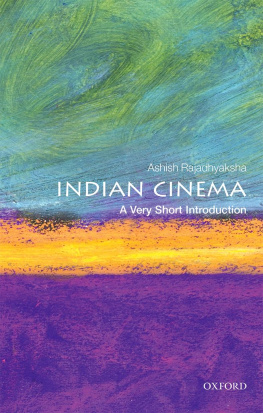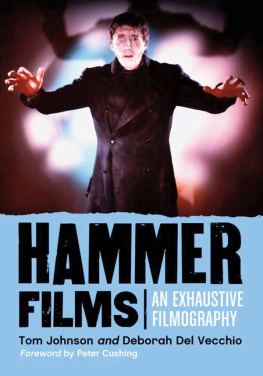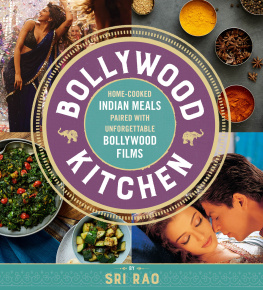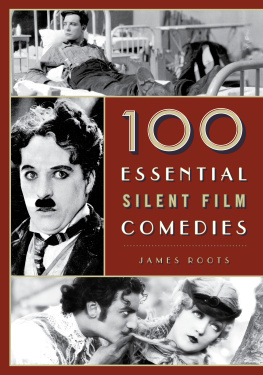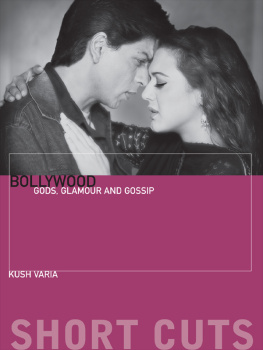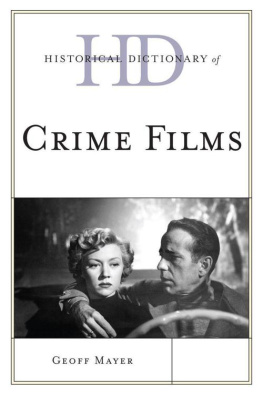Dasgupta Rohit K. - 100 Essential Indian Films
Here you can read online Dasgupta Rohit K. - 100 Essential Indian Films full text of the book (entire story) in english for free. Download pdf and epub, get meaning, cover and reviews about this ebook. City: India, year: 2019;2018, publisher: Rowman & Littlefield Publishers, genre: Non-fiction. Description of the work, (preface) as well as reviews are available. Best literature library LitArk.com created for fans of good reading and offers a wide selection of genres:
Romance novel
Science fiction
Adventure
Detective
Science
History
Home and family
Prose
Art
Politics
Computer
Non-fiction
Religion
Business
Children
Humor
Choose a favorite category and find really read worthwhile books. Enjoy immersion in the world of imagination, feel the emotions of the characters or learn something new for yourself, make an fascinating discovery.
- Book:100 Essential Indian Films
- Author:
- Publisher:Rowman & Littlefield Publishers
- Genre:
- Year:2019;2018
- City:India
- Rating:5 / 5
- Favourites:Add to favourites
- Your mark:
- 100
- 1
- 2
- 3
- 4
- 5
100 Essential Indian Films: summary, description and annotation
We offer to read an annotation, description, summary or preface (depends on what the author of the book "100 Essential Indian Films" wrote himself). If you haven't found the necessary information about the book — write in the comments, we will try to find it.
100 Essential Indian Films — read online for free the complete book (whole text) full work
Below is the text of the book, divided by pages. System saving the place of the last page read, allows you to conveniently read the book "100 Essential Indian Films" online for free, without having to search again every time where you left off. Put a bookmark, and you can go to the page where you finished reading at any time.
Font size:
Interval:
Bookmark:
100 Essential Indian Films
National Cinema Series
Series Editor: Cynthia J. Miller
The Encyclopedia of Japanese Horror Films edited by Salvador Jimenez Murgua
Encyclopedia of Racism in American Film edited by Salvador Jimenez Murgua
Encyclopedia of Contemporary Spanish Films edited by Salvador Jimenez Murgua and Alex Pinar
Spaghetti Westerns: A Viewers Guide by Aliza S. Wong
100 Essential Indian Films by Rohit K. Dasgupta and Sangeeta Datta
100 Essential Indian Films
Rohit K. Dasgupta and Sangeeta Datta
Rowman & Littlefield
Lanham Boulder New York London
Published by Rowman & Littlefield
An imprint of The Rowman & Littlefield Publishing Group, Inc.
4501 Forbes Boulevard, Suite 200, Lanham, Maryland 20706
www.rowman.com
6 Tinworth Street, London SE11 5AL
Copyright 2019 by The Rowman & Littlefield Publishing Group, Inc.
All rights reserved. No part of this book may be reproduced in any form or by any electronic or mechanical means, including information storage and retrieval systems, without written permission from the publisher, except by a reviewer who may quote passages in a review.
British Library Cataloguing in Publication Information Available
Library of Congress Cataloging-in-Publication Data
Names: Dasgupta, Rohit K., author. | Datta, Sangeeta, author.
Title: 100 essential Indian films / Rohit K. Dasgupta and Sangeeta Datta.
Other titles: One hundred essential Indian films
Description: Lanham : Rowman & Littlefield, [2019] | Series: National cinema series | Includes bibliographical references and index.
Identifiers: LCCN 2018027714 (print) | LCCN 2018034593 (ebook) | ISBN 9781442277991 (electronic) | ISBN 9781442277984 | ISBN 9781442277984(hardback : alk. paper)
Subjects: LCSH: Motion picturesIndia.
Classification: LCC PN1993.5.I8 (ebook) | LCC PN1993.5.I8 D277 2019 (print) | DDC 791.430954dc23
LC record available at https://lccn.loc.gov/2018027714
 The paper used in this publication meets the minimum requirements of American National Standard for Information SciencesPermanence of Paper for Printed Library Materials, ANSI/NISO Z39.48-1992.
The paper used in this publication meets the minimum requirements of American National Standard for Information SciencesPermanence of Paper for Printed Library Materials, ANSI/NISO Z39.48-1992.
Printed in the United States of America
For K. Moti Gokulsing,
who first encouraged Rohit Dasgupta to start writing on Indian cinema.
Contents
Introduction
The Indian cinema industry is the largest producer of films in the world. India has overtaken Japan and the United States and generates an astonishing one thousand films a year. It has more than twenty-five languages, and Hindi is the national language. An average of 230 films are made in Hindi in the Mumbai-based Bollywood industry alone. While this is the largest industry in North India, it is not by any means representative of the south. The Tamil film industry rules the south, followed by Telegu films. These films also enjoy both large native and diasporic audiences. Indian cinema is the largest entertainment industry for Indian audiences. For viewers ranging from the illiterate to the privileged upper class, these films must cater to a large and diverse audience. In addition, there is the Indian diaspora audiencemore than twenty million individuals, spread around the worldbut concentrated largely in the United Kingdom, Europe, and North America. Cinema is the strongest link to the motherland, family values, nostalgia, and romance for these audiences, who have been crucial in moving Indian cinema to the center of global popular culture.
Indian cinema was traditionally categorized as belonging to either the popular or art house genres. Popular mainstream cinema involves, as in the Hollywood tradition, star power, metropolitan narratives, and song and dance sequences. This cinema mostly hinges on archetypal characters and the brand of the lead star and largely offers a fantasized and simplified world. Popular regional films can be quite diverse and different from Hindi cinema. Indian cinema also encompasses a wide range of regional films all with their own regional industries such as Tollywood (Bengali cinema), Kollywood (Tamil cinema), Mollywood (Malayalam cinema), and so on. In recent years, film industries have also grown in languages such as Bhojpuri, which was not seen as a traditional film industry. The art house cinema movement can be traced back to the 1950s in West Bengal. It was inspired by the Italian neorealism movement and was led by Bengali filmmakers such as Satyajit Ray, Bimal Roy, and Mrinal Sen. These were marked by the rejection of studio and star systems and the use of real locations, nonactors, and small budgets. Mrinal Sens Bhuvan Shom , supported by state finance, officially marked the parallel cinema movement. This cinema worked within a realist aesthetic, often with rural narratives, and introduced a flourishing talent of directors, actors, and technicians trained by institutes of film and drama.
According to Gokulsing and Dissanayake, Bollywood cinema occupies an ambiguous space between the two, generating contradictory approaches and viewpoints. While scholars such as Dwyer see Bollywood as a depiction of the realities and aspirations of contemporary India, others condemn it for being superficial and trivial and as a promoter of uncritical pleasure associated with rampant consumerism. In her ethnography and interviews with young audiences on the internet, Christaine Brosius found that words like tacky and superficial were widely used to describe these films. Gokulsing and Dissanayake further argue that the most vocal opposition to Bollywood and its advocates has come from Indian art house film directors. This is understandable because, in terms of theme, style, technique, and intent, Bollywood stands in direct contrast to the ambitions of the parallel cinema of India. They contend that the cinematic discourse of art films is shaped by the dictates of realism and psychological complexity, that of Bollywood is driven by specularity. Specularity refers to the ways in which filmmakers seek to enhance the visual appeal of their works, at times excessively so, by making use of a broad range of visual effects and circuits of desire associated with the consumer society.
In this introduction, we chart the journey of Indian cinema from its early silent era to its contemporary forms. In so doing, we pay particular attention to issues around historiography, regionalism, genres and themes, and global markets; finally, we offer a word on the films that have been selected in this book.
The Historical Beginnings
The first fully indigenous Indian film made in the silent era was Raja Harischandra by Dadasaheb Phalke in May 1913. The film was based on the legend of Raja Harishchandra, recounted in the Indian epics Ramayana , and tells the story of an honest king who sacrifices his kingdom and family in order to uphold the truth and honor a promise he had made. Most silent films during this time were based on Indian mythology and historicals. Silent films were accompanied by live music, and men played womens roles. By the 1920s, however, women started to work as actors in the industry. Films like Shiraz (an Indo-German coproduction) and Throw of the Dice were very popular and have now been digitally restored. These films were curated for festivals and presented with live music. Phalkes films evoked stories from the epics and from god Krishnas life. Mythologicals and historicals contributed to nationalism as the British did not interfere or censor unless content was overtly political. Audiences found a sense of India as the nationalist movement started to develop during the early twentieth century.
Talkies arrived in the 1930s, introducing changes like singing stars and adaptations of famous novels by Indian writers like Saratchandra (the Indian equivalent to Charles Dickens). The studio system was consolidated in this era, and the resulting three major studios became very influential: Prabhat Studios in Pune, Bombay Talkies, and New Theatres in Calcutta. Content shifted from mythologicals and historicals to contemporary social narratives, dealing with issues of caste, class, gender, and urban life. New Theatres made films on Bengali literature for a pan-Indian audience, presenting cinema as respectable and suitable for family audiences. The studio produced Devdas (adapted from Saratchandras novel) in Bengali and Hindi, and this became one of the most influential films of all time. Bombay Talkies made films like Achyut Kanya , which critiqued the caste system and hierarchy, while Prabhat Studios made mythologicals such as the very popular Ayodhyache Raja ( The King of Ayodhya ), as well as the first proto-feminist film, Amar Jyoti , in which a young woman turns against the state and becomes a pirate when she is denied access to her own son.
Next pageFont size:
Interval:
Bookmark:
Similar books «100 Essential Indian Films»
Look at similar books to 100 Essential Indian Films. We have selected literature similar in name and meaning in the hope of providing readers with more options to find new, interesting, not yet read works.
Discussion, reviews of the book 100 Essential Indian Films and just readers' own opinions. Leave your comments, write what you think about the work, its meaning or the main characters. Specify what exactly you liked and what you didn't like, and why you think so.



